|
To Part Two
Thanks to Kevin O’Neill a Texas 200 veteran who collected
most of this data and thanks to all those who sailed in 2008 and
2009, contributing their suggestions for those who aspire to begin
the voyage or just complete it. Sail on!
What is it about the Texas 200 that makes it such a hard event
to complete? Why do roughly forty percent of all the boats that
leave Port Mansfield never make it to the end in Magnolia Beach?
Is it the type of boat sailed, the weather, the climate, the sailor
himself or just bad karma? A number of veterans of the endurance
sail that is the Texas 200 responded with comments, suggestions
and advice for those considering the event for this year.
Perhaps of all the answers Skip Johnson’s said it best.
Skip has never completed the Texas 200 but he continues to try.
“First, it’s serious. Even the well prepared operate
at the mercy of the Fates and Murphy. Second, a flexible attitude
coupled with the appreciation of where you are, physically, mentally,
emotionally and navigationally are essential when challenges arise.
Third, enjoy the adventure. It would have been nice to arrive
at Magnolia Beach sans the hitchhiking but I don’t regret
having made the effort. The whole experience was one of adventure,
companionship and finding your limits.”
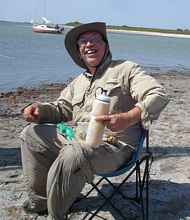 |
"First, it’s serious," Skip
Johnson |
Reading over sailors’ comments one criteria stood out as
most important. Gordo Barcomb, Puddleduck
Racer said it all. “I would add that really
boat prep and equipment, while important, are less an issue than
attitude and character. I have done so many things in life that
tried my strength and ability to persevere. If someone has a history
of giving up or avoiding challenges, this isn’t for them.
I love having to really struggle to achieve. That’s who
likes this stuff!”
Another Puddleducker, Jon Kowitz agreed with Gordo.” First
and foremost, there is contending with the course’s hazards
and basic necessities. If you’ve got the basics covered,
then after that it’s all attitude. How badly do you want
to make it? If you want it badly enough, you’ll drag the
wreckage of your ruined boat to Magnolia Beach with your bare
hands. If you don’t really want it, you’ll give up
and pull out the first time you ship a little water over the nose
of the boat.”
So, it is an endurance event. Conditions are not always favorable,
there are hazards, there is a lot of wind and sun, skinny water
and long hours on the water. Sixty percent of those who started
in Port Mansfield finished, forty percent did not. Even those
who did not finish, who lost equipment or even boats, still gave
the Texas 200 a thumbs up. Most will be back again in 2010 to
try to make it to Army Hole or all the way to Magnolia Beach,
whatever their personal goals of completion are. For each sailor
the goal and the achievements taken away from the Texas 200 are
both different and personal. But many agree it has changed their
lives for the better. They invite others to join them and offer
advice to make it to the end.
“The Texas 200 is not a sailboat race,” says Kevin
Nicolin. “It’s a five day, 200 mile survival test.
This mind set is the key to the successful completion of the route.
The wise skipper will adopt a conservative sailing approach so
as to not over stress his boat in the typical 20 to 30 knot winds
that dominate the event.” Additionally, Kevin notes, “The
Texas 200 is not for the novice sailor, nor for the unskilled
navigator. An abundance of shoals and navigation challenges demand,
not only careful advance planning, but quick, decisive and correct
decision making as a variety of restricted water maneuvering situations
are negotiated. Additionally, the prevailing local weather conditions
require an experienced skipper who can react properly to extremely
challenging circumstances at sea.”
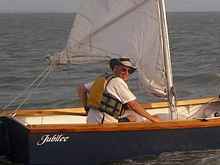 |
“It’s a five day, 200 mile survival
test." Kevin Nicolin |
“The Texas 200 is more mental than physical,” agrees
another Ducker, Andrew Linn. “The wind is strong, but nearly
constant. Some of the water is large, but it is warm and shallow.
The route is desolate, but there are many people out there, as
well as cities and towns. While it isn’t particularly safe,
a person would have a hard time dying during the Texas 200. While
it isn’t particularly difficult, you have to be determined
to finish.”
Andrew’s number one piece of advice? “Trust your
boat. Trust your boat, you can survive anything. And “pod
up”. The human spirit is an exponentially additive entity.
Doing the Texas 200 solo would be a disheartening experience.
It’s all mental. The more Ducks there are, the easier it
is, but it ain’t ever easy. If you wanna prep for the Texas
200 in a PDR, go sit outside in the sun and the wind for ten hours.
Did you like that? Ok, now do it for four more days!”
“Attitude is definitely a big factor in successfully completing
any challenging or potentially risky endeavor,” agrees Chuck
Pierce. “When we got back to Port Mansfield on Sunday evening
after we had made the shuttle to Magnolia Beach, I can remember
commenting to my brother-in-law Bryon who crewed with me, “Well,
at this point we are committed to finishing.” Although I
would be the last one to second guess anyone’s decision
to pull out and think no less of those who did, our boat would
have had to have been damaged to the point that it was unsailable
for us to have quit. It was a challenging course but we knew that
going into the event.”
Chuck Leinweber, owner of Duckworks Magazine began the TX 200
two years ago as a way to get a few friends to join him in a sail
along the south Texas coast. Those friends have morphed into an
army of devotees. Chuck believes that the most important thing
is the boat. “It should be handy and shallow draft. You
need to be able to get it off a reef by yourself or with your
crew. If you go aground, and you will go aground, you don’t
want to be wrestling that thing in neck deep water. You want to
be in knee deep water or less so that you have a chance of getting
back to deeper water.”
He adds, “You need a boat that will reef easily. The second
most important thing is to reef early and reef often. Don’t
be afraid to reduce sail - usually your boat will sail better-
often faster with less sail. That is counter-intuitive but true.
After those two important things there are a lot of less important
things.”
“No one is going to do well on the course we are traveling
in a deep keeled boat. You could sail the Intercoastal Waterway
just fine, but this is beach cruising and you need the right boat
for it.” Chuck commissioned Jim Michalak to design the Laguna
23 specifically for such beach cruising. A fleet of Lagunas are
being built with shallow draft, large open cockpits, lee boards
and beach friendly design.
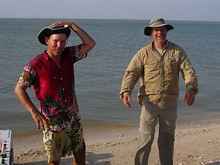 |
"If you wanna prep for the Texas 200 in
a PDR, go sit outside in the sun and the wind for ten hours.
Did you like that? Ok, now do it for four more days!”
Andrew Linn (standing with Gordon Barcomb left) |
Stan Roberts, veteran of both years sailings, echoes Chuck’s
thoughts on bringing the right boat. Stan says, “Just because
you already own a Blubber 9 or a Screaming Photon 12 doesn’t
make it a good choice. The Texas 200 is not a race. There is no
race committee to yell at when your boat is dismasted, rolled,
the rudder shredded, all your gear lost. You need a boat that
can handle shallow water, high winds and steep bay chop with waves
to four feet.” Additionally, Stan adds is the fact you will
have to push your boat off from shoals or beaches, probably tow
it some distance by hand, usually in waves and often against the
wind. Stan knows what he is talking about. The first year his
Piccup pram was overpowered by large waves
in Aransas Bay. The second year he brought a larger boat.
No one will deny that the Puddleduck Racers have successfully
sailed the Texas 200 in their small four by eight boxy boats.
All Ducks have made it to Magnolia Beach in both years, rescuing
and assisting many others in the 2009 sailing. They are undeniably
the heroes of the TX 200 legend. Yet Kevin Hahn, who crewed on
several boats and was himself involved in more than one rescue
and assist worries that this very success will lull other small
boaters into a false sense of security in attempting the Texas
200.
“I think the other big thing people need to watch out for
is what I call the “Puddleduck Trap.” A lot of people
may look at the Texas 200 stories and think to themselves, “If
these guys can do that in those eight foot Ducks, then my nine
to fourteen foot pond sailor will be just fine.” Kevin added,
“I think this is a horrible misconception and needs to be
avoided. The only real limiting factor on a Duck is speed. If
you pulled the mast and rowed, you could use the average Duck
as a small rescue craft. With a high freeboard and a modest sail
plan, you are just moving slow and steadily. The Ducks have a
much higher stability than people give them credit for.”
Californian Kim Apel crewed on a Core Sound 17 in the 2009 sail.
“Among the things I got right were choosing a good partner
and starting with the right attitude. We never had a cross word
between us, despite a fair amount of stress. We were in an appropriate
boat, the Core Sound 17, but among the things we didn’t
get right was lacking tools and spare parts to respond to problems
when they came up with the boat. The boat wasn’t prepared
for the stresses that were experienced. We did seek help and accept
it when needed and that kept us in the game for awhile.”
A two time veteran of the Texas 200, Bobby Chilek feels that
in preparing for the Texas 200 boat selection and preparation
of the boat are very important. “Skinny, tipsy boats are
not good, but heavy keel boats are not much better if you head
into shallow water. The boat needs to handle a following sea.
If conditions are the same as for the past two years, you will
be in three to four foot seas at times. Make sure you can handle
you boat in rough conditions for long periods, the hours turn
into days. “
|
“Skinny, tipsy boats are not good..."
Bobby Chilek |
Bobby says, “Check your reefing capabilities, winds in
excess of twenty miles per hour, with gusts to thirty have been
the norm the past two years. Go over the boat with a fine tooth
comb, pay careful attention to the rudder, mast and any standing
rigging. The rudder will be subjected to some heavy loads in the
following seas. The mast will be seeing more wind than most of
us normally elect to sail in. Materials for the boat need to be
of the strongest capabilities to withstand the stresses.”
“If you select a good boat, prepare it well and practice
in the roughest conditions you can, these three steps will put
you on your way to completing the Texas 200,” Bobby feels.
“The Texas 200 requires a sturdy boat built to withstand
high winds and seas,” says Kevin Nicolin. “It should
be of shallow draft and most importantly, have the ability to
reduce sail. Mainsails should have two rows of reef points, jibs
with roller furling capability are a big plus. The skipper and
his crew must be able to reduce sail quickly, often in a downwind
scenario.” Kevin believes that only the most highly skilled
skippers should attempt to sail the Texas 200 singlehanded.
The importance of reefing was stressed over and over in all sailors’
comments. Mike Monies who was dismasted in a capsize felt it was
the most important point to emphasize for new members. “We
go to Texas for the wind. Be prepared for it. It is going to blow
steadily and often in higher gusts. You must have reef points
on your sails. You must be able to reef your sails from inside
the boat while on the water.” Mike had only one set of reef
points on his leg-o-mutton sail in 2009 but will have two sets
of reef points on the lug sails he will use in 2010. He pointed
out that many types of sails are difficult to reef down well or
easily and should be considered when planning what kind of boat
or sails to use.
Kenneth Purdy agreed with Mike’s viewpoint on reefing.
“Many people had trouble because they did not reef early
enough. Reef early and if you make your own sails, heavily reinforce
the sail in the area around the reef points.”
Kevin Nicolin points out, “Last year my son and I sailed
our Core Sound 17 with both main and mizzen double-reefed four
of the five days of the Texas 200. If your style is to maximize
canvas in order to sail as fast as possible, you’re asking
for trouble and this event is probably not for you.”
|
"How badly do you want to make it? If you
want it badly enough, you’ll drag the wreckage of your
ruined boat to Magnolia Beach with your bare hands."
Jon Kowitz |
“You are going to get more wind than you are used to, so
have a deeper reef than you think you need, “advises Dan.
St. Gean. “Know when to reef! Either use the Beaufort scale
or some other visual reference. Wind indicators have to be combined
with boat speed downwind in order to get true readings.”
Dan added, “You are going to be going downwind for at least
two days. Make sure you can sail balanced without weather or lee
helm in twenty knots downwind without too much stress.”
Many others agreed with Dan on this point. “Some of the
boats did not have adequate reefing capabilities,” agreed
Chuck Pierce. “Make sure you can reef to the point that
the boat can sail well in 20-25 knot winds.”
Gordo Barcomb admits he did not realize the importance of reefing.
“My big issue was reefing. I thought I wouldn’t need
to since I had a small sail. Wrong!!!” Fellow Ducker Andrew
Linn found that when he finally reefed his sail down on his PDR
he not only sailed better but he made better time. He said, “Go
figure. Who’da thunk making the sail smaller would make
it go faster?”
How do you prepare for sailing in conditions that may be totally
different than those in which you normally sail? Veteran sailor
and boat designer John Welsford commented, “One learns from
mistakes and cruisers don’t normally push hard enough to
make those learning opportunities happen because the consequences
are too severe, so when they do push hard they get beyond their
experience level very quickly.”
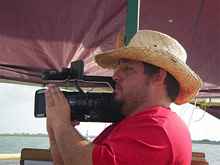 |
“I think the other big thing people need
to watch out for is what I call the “Puddleduck Trap.”
Kevin Hahn |
JohnW added, “Sail the boat nonstop for ten hours, take
it home and change everything that did not work or is not comfortable.
Do it again. And again. Three times minimum.”
“Be adaptable, have perseverance and be ready to deal with
what you are thrown,” says Dan St. Gean. “Lots of
boats had trouble because at home they don’t go out on Small
Craft Advisory days. That’s most every day in south Texas
in the early summer. Don’t be fooled by the Intercoastal
Waterway. The bays are big and small craft will have trouble with
the short, steep chop that it kicks up. Sometimes larger ocean
swells are a lot more friendly than the two to three foot chop
you will find in San Antonio Bay.”
Skip Johnson points out that to prep for the Texas 200 you need
to sail your boat. “ Sail your boat . Then sail some more.
Sail an overnight trip, sail in high winds. With crew if you intend
to sail with a crew, solo if solo.”
“An important thing would be to go sailing a few times
in the boat you are doing the trip in with whoever is crewing,”
points out Chuck Pierce. “Because of medical issues we didn’t
get to do much sailing before the Texas 200. My brother-in-law
and I have spent a lot of time together over the years in other
boats, but he had been out only a few times in the Potter 19.
It took him a couple of days to learn where everything was and
get comfortable with the boat.”
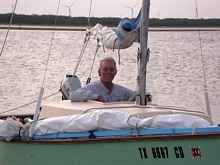 |
“Just because you already own a Blubber
9 or a Screaming Photon 12 doesn’t make it a good choice."
Stan Roberts |
Dan St. Gean agrees with Chuck. “One lesson we learned
was that you must test sail under challenging conditions. In our
case we did not do so at all. The second lesson is to bring good
crew, single-handing a boat on the Texas 200 is more than twice
as hard.”
“If you’ve never sailed for five hours straight in
at least 25 knot winds with five miles of fetch (the 5-25-5 rule,
if you’ve never gotten underway or maneuvered dockside in
those same windy conditions…..stay home,” advises
Kevin Nicolin. “Last year one boat was holed (T-boned) by
another attempting a landing in high winds.”
Kevin O’Neill advises, “Take the boat you’re
going to bring, loaded with all the stuff you’re going to
take and the crew you’re going to sail with. Go to the leeward
end of the biggest lake you can find, somewhere that there’s
a lot of fetch so you can actually see some chop. Go on a weekend
when there are Small Craft warnings posted with winds over twenty
miles per hour. Sail all weekend without stop, back and forth,
beating and running and reaching. Put forty miles on your GPS
both days. Get used to several hours of on end steering. When
you need to eat or pee or drink or put on SPF 30, someone still
has to steer. More than anything though, be sure that you and
the boat can both handle big wind and waves for hours on end.
That’s what you are in for.”
Words to the wise about capsize. There were several capsizes
in past Texas 200 events, some of which resulted in loss of masts,
sails, gear, equipment, even boats. Bill Moffitt offers these
observations, “If you are careful and lucky, you won’t
capsize. Otherwise, be sure to have practiced this maneuver several
times, at least once with all your gear aboard.See where your
gear ends up and strap down accordingly. If you don’t need
your GPS, the VHF hand-held, the binoculars or the bailing bucket,
then don’t bother to tether them to the boat at all times.”
Adds Bill, “Imagine waves slapping up over your hatches
until you get upright. How much do they really leak? Oh, and where
are your oars, shoes, hat, glasses and flask? Do try to plan for
the worse.”
Mike Monies thought he had tied down his gear securely and attached
a tether to his mast. When he dismasted in a capsize he found
gear floating away and the mast and sail gone. Mike plans different
strategies this year. “I added additional flotation to the
Laguna, beyond the plan’s requirement. I added more watertight
lockers and hatches to stow gear away in. The masts and sails
will be more buoyant and secured. Nothing should be loose in the
boat. We will have safety lines or tethers for those sailing her.”
|
"That’s what you are in for.”
Kevin O’Neill |
Safety harnesses and safety lines were strong recommendations
from John Welsford, who suggested them to both Stan Roberts and
Mike. JohnW said, “If sailing single handed in rough conditions
and away from the shore, I strongly suggest wearing a safety harness
and line. Mine is a bit over six meters long (about 20 feet),
has two clips and a full harness. I’ve been glad of it a
couple of times.” John explained, “The reason for
the long safety line is twofold. One is that I have a hook at
the far end and another 2.5 meter from the end. That enables me
to alter my securing point when moving about the boat without
having the line unclipped at any time. The other is if the boat
is on its’ side it is then necessary to swim up to the bow
and get her head to wind, then back to the mast to get the main
halyard loose and the main down, then around to the centerboard
to climb up and heave her back upright. With enough length in
the safety line you can do all this without unclipping.”
“After many years of single handed cruising in open boats
I find that staying afloat is not an issue, so a lot of times
I do not wear my PFD,” JohnW admits. “But staying
with a boat can be a problem, as it will often drift faster than
a person encumbered with wet weather gear and boots can swim.
I have come to the conclusion after much experimentation that
for the unique needs of single handed open boats in open waters,
the best combination is a kayak vest which allows a lot more movement
of the torso and the long tether line with its two clips well
apart.”
Stan Roberts agreed that Mike’s difficulties in the high
winds and water after his capsize pointed out the difficulties
a sailor faces in righting a small boat in the Texas 200, should
they be broached or knocked down. Stan said, “Thanks JohnW
for the information on self rescue for small boats. I plan to
wear my PFD and a safety harness with a long tether on the next
Texas 200 because it makes sense in dinghy cruising.”
Personal flotation devices or PFD’s are absolutely essential
for those sailing in the Texas 200 or any other challenge or raid
type event. The possibility of capsize, broaching and swamping
exists daily, as well as accidental overboards due to slips, falls
or other mishaps. The majority of those sailing agreed that they
wore their PFD’s at all times and the comfort of the style
chosen played a major part in doing so. Stan Roberts found that
a non-inflatable PFD with large pockets for gear worked best.
Stan offers good advice in regards to PFD’s. “First,
everyone should wear one the entire time you are on the water.
In a capsize, the first thing that floats off are the PFD’s.
The second thing that floats off is the boat, faster than you
can swim. Second, get a PFD that is very comfortable and has pockets.
You will wear it if it’s comfy and stuffing all the essentials
in the pockets saves a lot of searching motions in a small boat.
Third, buy a bright color and skip the camo ones, you will want
to be seen at a distance. Fourth, inflatable jackets are like
parachutes. There is always a question of whether they are going
to open/inflate or not when you pull the string. Make sure it
has a manual inflation tube also. Mine was designed for kayaking
and is very comfortable. In addition it makes a nice pillow at
night for camping.”
John Miller adds, “Back in the 80”s while sailing
beach cats on the coast, we always wore life jackets. Maybe it
was just to get them out of the way or maybe for safety. My favorite
PFD was a lightweight jacket with a lot of flotation up front
and not much on the sides or back. It worked well in the Texas
heat and I still have it and use it on board boats and catamarans.”
John believes if your PFD is comfortable for the conditions you
will wear it. He added, “Use the spare square PFD for a
seat cushion.”
“When sailing or motor boating, I can’t see not wearing
your PFD,” says Gordo Barcomb. “There’s little
concern for extreme physical strain and the ramifications of hitting
the water are all too great. The main reason given for not wearing
a PFD is discomfort, so no matter what style you choose, comfort
is key. I once saw an older gentleman walking all around Academy
Sports with a PFD on. I assumed he was making sure he liked it!”
“Actually my PFD was comfortable to sail in,” agrees
Mike Monies, “and I wore it constantly on the trip. I never
sweated once on the whole trip so it must not have been hot to
wear. All vests seem to ride up when you are in the water.”
Stan Roberts pointed out, “Mike’s a good example.
Mike spent 30 minutes to an hour in the water in large waves trying
to deal with a capsized boat. He was exhausted by the time he
reached land. He lost a lot of his equipment because it floated
off after the capsize. However, he was alive, functional and continued
on to finish the Texas 200 because he wore a PFD instead of using
it as a chair or a footstool.”
The advice offered today is only part of the suggestions from
the 2008-2009 Texas 200 veterans. Part Two will cover gear for
the boat, supplies, personal gear, provisions, physical preparedness,
sailing and navigational ability. Advice concerning weather, geography,
water and wind conditions, and more about the psychological and
mental preparation will be expanded on. The Texas 200 requires
a great deal of organization and preparation in all these area
and those who have sailed successfully hope their lessons learned
will help avoid future mishaps in 2010.
The mantra for the Texas 200 is: Prepare, prepare, then prepare
some more.
Reef, then reef some more. Sail, then sail some more. Pack the
boat, then sail it packed.
Sail with your crew, then sail with your crew and the boat packed.
Sail in conditions you would not normally sail in, then try it
again.
One sailor who was considering sailing in the Everglades Challenge
a few years ago took this exact advice. He did all the above.
And? He did not sail in the Everglades Challenge. He saw his limitations
when confronted with sailing conditions that exceeded his experience.
Bill Moffitt, veteran sailor said the same thing. “This
should be a step down from other things you have done in the past,
not a step up. If you are not prepared you are putting not only
yourself in danger but those who will try to help you in danger.
And that is not fair.”
|
"There is no such thing as packing too
much whiskey” Bill Moffitt |
“Most importantly, bring enough whiskey to see you through
to the end. There is no such thing as packing too much whiskey,”
Bill said. Or as the Ducks would put it, “Now we know why
the rum is always gone.”
“Preparation is not necessary as long as you are prepared
to accept the consequences” is a favorite quotation of another
veteran Texas 200 sailor. We will explore how to get ready for
the mud, sun, bugs, wind, waves, exhaustion and general fun and
mayhem of the Texas 200 in Part 2 next month. Thanks to all those
who contributed their time and thoughts to make this article possible.
*** |

